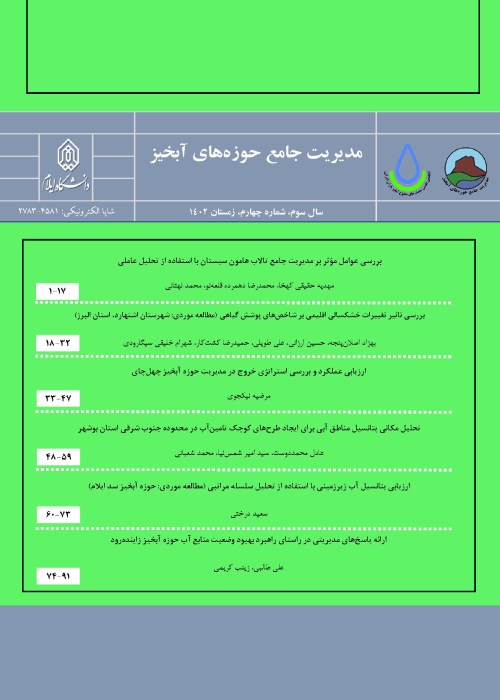The Impact of Warm-Up Period Length of Hydrological Models on Runoff Simulation
Extended AbstractIntroductionHydrological modeling is an essential tool in water resources management, and its accuracy and reliability are critical to successful design, planning, and decision-making processes. Calibration and validation are two essential processes used to evaluate the performance of hydrological models. The warm-up period is a crucial component of hydrological modeling that allows the model to reach an equilibrium state by representing the initial system conditions accurately.This study aimed to investigate the impact of the length of the warm-up period on the performance of four different hydrological models, namely AWBM, Sacramento, SimHyd, and TANK, in the Kashkan watershed. The study used different optimization methods in the RRL software package during the calibration and validation periods. The proposed warm-up periods of 5%, 7%, and 10% of the initial data length were used without considering drought and wet conditions.The findings of this study provide valuable insights into the impact of the warm-up period on hydrological modeling performance. The study showed that the length of the warm-up period does have a significant impact on model performance, with the best results obtained when the warm-up period was set to 5% or 7% of the initial data length. These findings have important implications for the design and implementation of hydrological models, as they highlight the importance of carefully selecting the warm-up period length to ensure accurate and reliable modeling results. Overall, this study adds to the body of knowledge on hydrological modeling and provides useful guidance for future research and practical applications.Materials and methodsThe Kashkan River watershed, with an area of over 9,000 hectares, was selected as the study area for this research. The Kashkan River is an important sub-watershed of the Karkheh River watershed, and daily rainfall, potential evapotranspiration, and potential evapotranspiration for the Kashkan watershed were used in this study, with a statistical period of 29 years (1988-2018). Since the rainfall-runoff process was investigated for the entire watershed, the Thiessen polygon method was used to obtain the weighted average of rainfall and evapotranspiration for the entire study area. Additionally, the Hargreaves-Samani (H-S) method was used to obtain potential evapotranspiration data.The data used in this study were divided into two parts, training and testing, based on trial and error and a review of sources. The training data accounted for 70% of the total data, while the remaining 30% was used for testing. The AWBM, Sacramento, SimHyd, and TANK models in the RRL software package were investigated, along with seven optimization methods using the Nash-Sutcliffe objective function.The findings of this study provide insights into the application of different hydrological models and optimization methods in the Kashkan River watershed. The study highlights the importance of accurately representing initial system conditions during modeling and the impact of the length of the warm-up period on model performance. These findings have important implications for water resource management, particularly in the design and implementation of hydrological models for the Kashkan River watershed and other similar regions.Results and DiscussionThis study examined the influence of different durations for the warm-up period on the calibration and validation of RRL software package models. Seven optimization methods and the Nash-Sutcliffe criterion were utilized in the analysis. Specifically, the warm-up phase of the software, which constitutes the initial segment of the statistical period, was investigated during the calibration and validation processes. Durations of 5%, 7%, and 10% were selected from the onset of the statistical period. The study involved conducting over 4000 iterations for all the examined models and optimizers.Given the characteristics of the optimizers, up to 5 iterations were performed for each optimizer in each model. The resulting average NSE value (Nash-Sutcliffe Efficiency) was analyzed and examined.The findings indicate that, on average, configuring the warm-up period to account for 5% and 7% of the complete dataset in the calibration and validation processes enhances the efficiency of the model compared to the recommended period suggested by the software. However, it is important to note that the outcomes may vary depending on the specific problem and prevailing conditions. Therefore, these results should be interpreted cautiously and in conjunction with other factors. Overall, this study offers a practical guideline for selecting an appropriate warm-up duration in the calibration and validation of RRL software package models.
- حق عضویت دریافتی صرف حمایت از نشریات عضو و نگهداری، تکمیل و توسعه مگیران میشود.
- پرداخت حق اشتراک و دانلود مقالات اجازه بازنشر آن در سایر رسانههای چاپی و دیجیتال را به کاربر نمیدهد.


